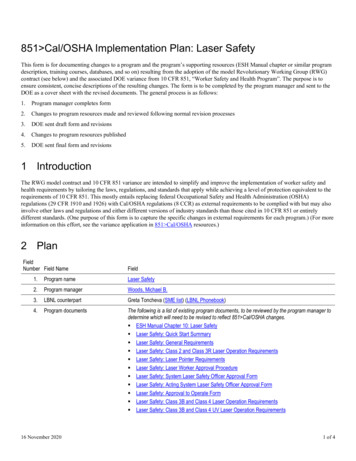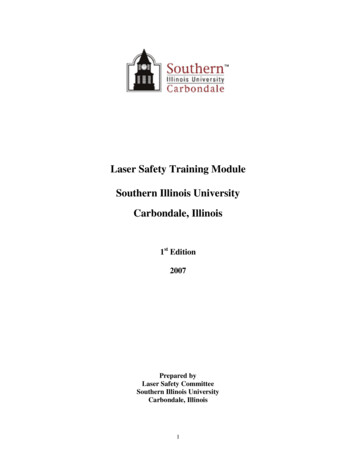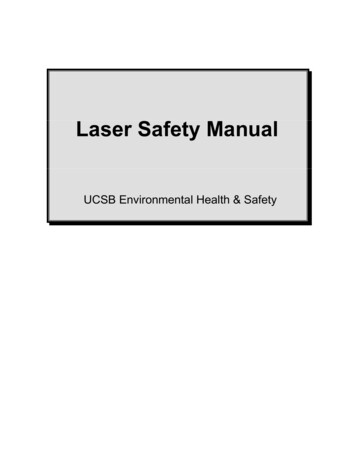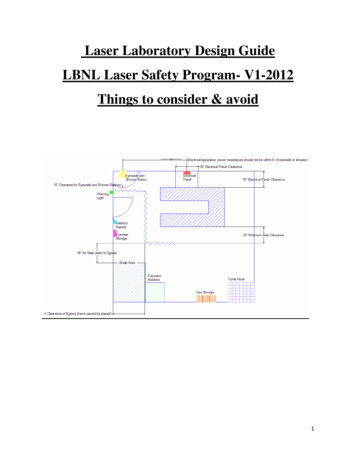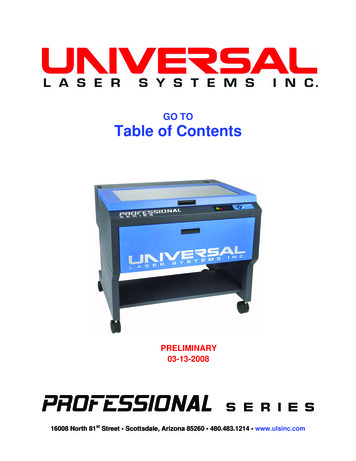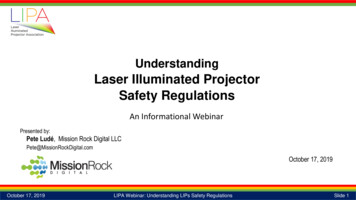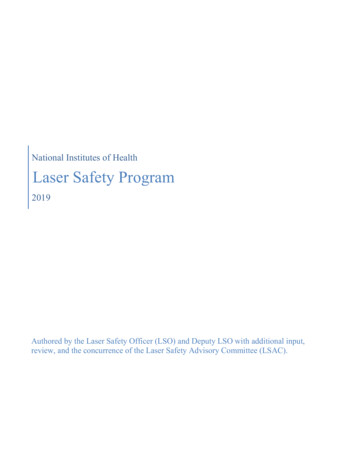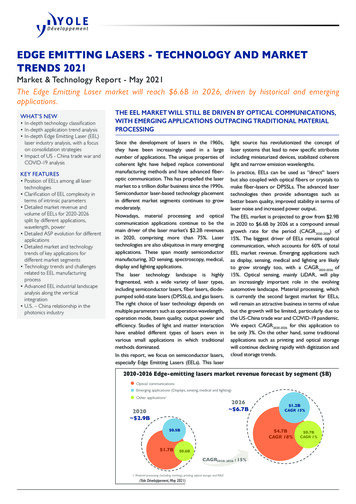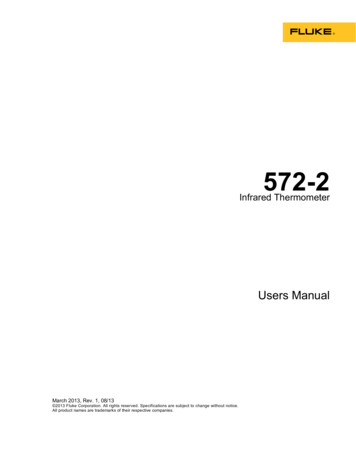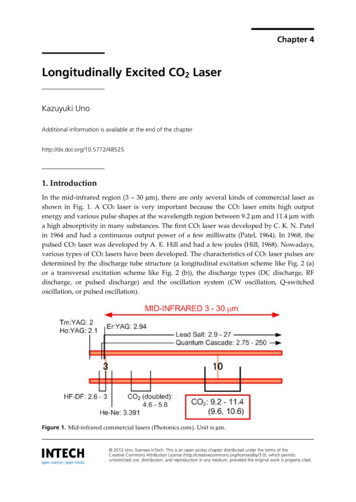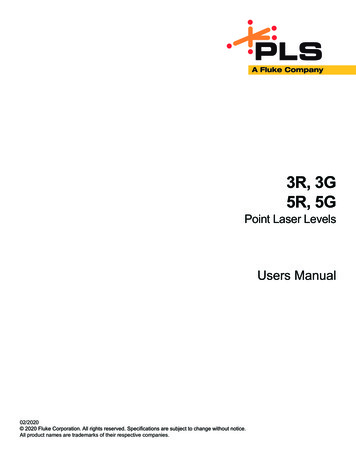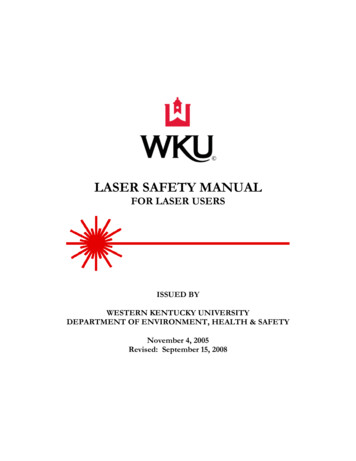
Transcription
LASER SAFETY MANUALFOR LASER USERSISSUED BYWESTERN KENTUCKY UNIVERSITYDEPARTMENT OF ENVIRONMENT, HEALTH & SAFETYNovember 4, 2005Revised: September 15, 2008
TABLE OF CONTENTSPOLICY AND SCOPE. 1ORGANIZATION OF THE LASER SAFETY PROGRAM .2LASER SAFETY OFFICER (LSO) .2LASER SAFETY COMMITTEE .2LASER SUPERVISOR .3LASER USER . 3CONTACT INFORMATION .4EMERGENCIES AND INCIDENT PROCEDURES .4COLLATERAL HAZARDS .4REGISTRATION OF LASERS AND LASER USERS .5APPENDIX A: ANSI Z136.1-2000 SAFE USE OF LASERS . 1APPENDIX B: LASER REGISTRATION FORM . 1APPENDIX C: LASER USER REGISTRATION & TRAINING INFORMATION . 1APPENDIX D: STANDARD OPERATING PROCEDURE TEMPLATE & EXAMPLE. 1TEMPLATE . 1EXAMPLE SOP .2APPENDIX E: NOTE ON MEDICAL SURVEILLANCE . 1APPENDIX F: SUMMARY OF TRAINING . 1REFRESHER TRAINING . 1APPENDIX G: SUMMARY OF CONTROL MEASURES . 1REFERENCES . 1Tables 10 and D1 reproduced with permission from ANSI Z136.1 (2000) American NationalStandard for Safe Use of Lasers. Copyright 2000, Laser Institute of America, Orlando,Florida. The Laser Institute of America disclaims any responsibility or liability resultingfrom the placement and use in the described manner.WKU Laser Safety ManualTable of Contents - i
POLICY and SCOPEThe primary objective of the Western Kentucky University (WKU) laser safety program is toensure that no laser radiation in excess of the maximum permissible exposure (MPE) limitreaches the human eye or skin. Additionally, the program is designed to ensure that adequateprotection against collateral hazards is provided. These collateral hazards include, but are notlimited to, the risk of electrical shock, fire hazard from a beam or from use of dyes andsolvents, chemical exposures from use of chemicals and vaporization of targets, and theemission of ionizing and non-ionizing radiation from power supplies associated with theoperation of the laser or laser system.WKU requires that all Class 3b and Class 4 lasers and laser systems be operated inaccordance with the American National Standards Institute (ANSI) Z136.1-2000, “Safe Useof Lasers” and other applicable federal and state regulations. To that end, WKU adoptsANSI Z136.1-2000 as its laser safety program. Exceptions to this standard will beconsidered on a case-by-case basis by the Laser Safety Officer (LSO). The LSO shalldocument and keep record of any policy decisions that are exceptions to the ANSI Z136.12000 standard.All Class 3b and Class 4 laser operations at WKU shall be registered with, reviewed andapproved by the WKU LSO. The LSO shall subsequently notify the Kentucky Supervisorof Radiation Producing Machines, Radiation Health Branch, Cabinet for Health and FamilyServices, Department of Public Health, of any Class 3b and Class 4 lasers or laser systemspossessed by Western Kentucky University. The LSO shall also notify this person of thedisposal of any Class 3b or Class 4 lasers or laser systems. Though not required by thispolicy, guidance is available from the LSO and in ANSI Z136.1-2000 for Class 1, Class 2,and Class 3a lasers.This manual shall be available for reference by all laser users at WKU. It is the responsibilityof the Laser Supervisor to maintain this manual for reference purposes. All persons usinglasers shall be familiar and comply with all requirements of this manual.WKU Laser Safety ManualPage 1 of 5
ORGANIZATION OF THE LASER SAFETY PROGRAMLaser Safety Officer (LSO)The Laser Safety Officer (LSO) is an individual that will effect the knowledgeable evaluationand control of laser hazards, and have the responsibility and authority to monitor andenforce the control of laser hazards. At the current time, the LSO shall be WKU’s RadiationSafety Officer. In an effort to make the laser safety program effective, the LSO will be givenauthority to accompany the responsibility of the position. The Laser Safety Officer atWestern Kentucky University is granted this authority by its President.The LSO shall be designated for all circumstances of operation, maintenance, and service ofa Class 3b or Class 4 laser or laser system.LSO Specific Responsibilities Classification or verification of laser classification for Class 3b or Class 4 lasers orlaser systems Hazard evaluation of laser areas, including Nominal Hazard Zones (NHZ) Recommendation or approval and auditing of functionality of control measures Approval of Standard Operating Procedures (SOPs) and alignment procedures Provide guidance for proper protective eyewear, barriers, etc. Provide appropriate warning signs for posting and labeling Approve of laser facilities, laser equipment, and modification of existing prior to use Conduct periodic safety audits of laser facilities and equipment Assist Laser Supervisors with safety education and training Determine need for medical surveillance Additionalo Provide or cause to provide consultative services on laser hazard evaluationand controls and on personnel training programso Establish and maintain adequate policies/procedures for the control of laserhazardso Suspend, restrict, or terminate laser or laser system operation if laser hazardcontrols are determined inadequateo Maintain records of all Class 3b and Class 4 lasers and laser operatorso Survey by inspection all areas where laser equipment is used and ensurecorrective action is taken where requiredo Participate in accident investigations involving laserso Approve laser or laser systems for operationLaser Safety CommitteeAt this time, it is not considered necessary to create a formal Laser Safety Committee atWestern Kentucky University due to the limited number of Class 3b and Class 4 lasers andlaser systems. However, the LSO will consult with various laser-knowledgeable people forthe review of Laser Registrations and for the consideration of laser issues as deemednecessary by the LSO.WKU Laser Safety ManualPage 2 of 5
Laser SupervisorThe laser supervisor will be knowledgeable of the requirements for laser safety, the potentiallaser hazards and associated control measures for all lasers and laser systems, education andall policies, practices and procedures pertaining to laser safety at locations under thesupervisor’s authority.The laser supervisor will1. comply with the requirements of the Laser Safety Manual and the LSO2. provide training on laser hazards and their control to all personnel who may workwith lasers under his/her jurisdiction3. write and be familiar with the standard operating procedures for Class 3b and Class 4lasers and ensure that these procedures are provided to users of such lasers4. not permit the operation of a laser unless there is adequate control of laser hazardsto employees, visitors, and the general public5. submit the names of individuals scheduled to work with lasers to the LSO6. submit information as requested by the LSO for medical surveillance and trainingcompletion7. immediately notify the LSO of known or suspected accidents resulting from lasersoperated under his/her authority8. not permit operation of a new or modified laser under his/her authority withoutapproval of the LSO9. make sure that plans for laser installation or modifications of installations aresubmitted to the LSO for approvalLaser UserLaser Users include faculty members, researchers, graduate and undergraduate students,operators, technicians, engineers, maintenance and service personnel, and any otherpersonnel, working with or around lasers.Laser Users shall use laser equipment in accordance with this Laser Safety Policy, ANSIZ136.1-2000 and direction from his/her Laser Supervisor and the LSO. A laser user will notenergize or work with or near a laser unless authorized to do so by the supervisor for thatlaser. The laser user will be familiar with all operating procedures.When a laser user knows or suspects that an accident has occurred involving that laser, or alaser operated by another employee, and that such accident has caused an injury or couldpotentially have caused an injury, he or she will immediately inform the supervisor. If thesupervisor is not available, the employee will notify the LSO.WKU Laser Safety ManualPage 3 of 5
CONTACT INFORMATIONEmergencies and Incident ProceduresPersons receiving or suspected of having received a harmful laser beam or non-beam hazardexposure must report such a fact or suspicion immediately to his/her Laser Supervisor andthe LSO.The LSO can be reached at:WKU Office (Regular Business Hours 8:00 a.m. – 4:30 p.m.): 745-7095WKU Cell (Anytime): 779-6601The Laser Supervisor’s contact information shall be posted in a conspicuous location in thelaser area.For emergencies, call 911 or 5-2548 from campus phones to reach the WKU Police. TheWKU Police will contact the appropriate emergency response agency.Collateral HazardsThere are multiple potential collateral hazards associated with the use of lasers and lasersystems. These hazards include, but are not necessarily limited to electrical, collateralradiation, fire, hazardous chemicals (dyes, solvents, flue and smoke filters, etc.), and lasergenerated air contaminants.The following individuals will be the primary contact in WKU Environment, Health &Safety if you have questions regarding these collateral hazards.Fire Safety/Fire Extinguisher SelectionFire Safety Officer, 745-2931Hazardous Waste DisposalEnvironmental Compliance Specialist, 745-6366Chemical Hazards/Air Contaminants/Lock-out Tag-outLab Safety Officer, 745-3168Radiation SafetyRadiation Safety Officer, 745-7095WKU Laser Safety ManualPage 4 of 5
REGISTRATION OF LASERS AND LASER USERSAll class 3b and 4 lasers must be registered with the LSO in WKU Environment, Health &Safety prior to installation and use. This may be accomplished by completing the laserregistration form in Appendix B.All class 3b and 4 laser users must be registered with Environment, Health & Safety prior toworking with class 3b or 4 lasers. The laser user registration form is located in Appendix C.WKU Laser Safety ManualPage 5 of 5
APPENDIX A: ANSI Z136.1-2000 Safe Use of LasersANSI Z136.1-2000 Safe Use of Lasers is incorporated by reference.Contact the LSO at 745-7095 for information on ordering a copy of thisstandard.The LSO has one copy of this standard and can loan it out for shortperiods of time.WKU Laser Safety ManualAppendix A – Page A1
APPENDIX B: LASER REGISTRATION FORMWestern Kentucky UniversityDepartment of Environment, Health & SafetyInstructions: All Class 3b and 4 lasers are required to be registered with the WKU Laser Safety Officer.Complete this form for each laser to be registered and forward to:Laser Safety Officer, Environment, Health & Safety, FAX: 5-5037User InformationLaser Supervisor:Phone:Laser Supervisor:Phone:Other Laser User:Phone:Other Laser User:Phone:Other Laser User:Phone:Laser InformationLaser Manufacturer:Model Number:Serial Number:Laser Location:DepartmentLaser Status:OperableInoperableBuildingStoredRoom NumberOtherLaser Type (Nd:YAG, CO2, etc):Classification (3b or 4):Wavelength (nm):*Beam Diameter at Exit of Laser(mm):WKU Laser Safety ManualAppendix B – Page B1
Beam Divergence (mrad):Continuous Wave:Average Power (Watts):orPulsed:Pulse Energy:Pulse Duration:Pulse Repetition Frequency(Joules per pulse)(Seconds)(Hz)orQ-switchedPulse Width:Energy:(Joules per pulse)Purpose or Use:*Note: Report the beam diameter at 1/e. If the beam diameter is reported by the manufacturer at 1/e2, thenyou can calculate 1/e by the following equation:11 e2e 2Comments:Laser Supervisor’s SignatureWKU Laser Safety ManualDateAppendix B – Page B2
APPENDIX C: LASER USER REGISTRATION &TRAINING INFORMATIONInstructions: All users of Class 3b and 4 lasers are required to be trained and registered with the WKULaser Safety Officer prior to using said lasers. Complete this form and forward to:Laser Safety Officer, Environment, Health & Safety, FAX: 5-5037Name:Phone:Building/Room #:Department:Laser Supervisor:List all laser or laser safety training course work you have completed. Note all the titles,dates completed, duration (hours of course) and locations.TitleDate CompletedSignature:Duration of TrainingLocation of TrainingDate:(Laser User)Signature:Date:(Laser Supervisor)WKU Laser Safety ManualAppendix C – Page C1
APPENDIX D: STANDARD OPERATING PROCEDURETEMPLATE & EXAMPLETemplate1. Introduction – Description of LaserType and wavelengthIntended applicationLocationAverage power or pulse energyPulse duration and repetition rate for pulsed lasersBeam diameter and divergence2. Hazards – List all hazards associated with laserEye and skin hazards from direct and diffuse exposuresElectrical hazardsLaser generated air contaminantsOther recognized hazards3. Control Measures – List control measures for each hazardInclude the following:Eyewear requirement, include wavelength and ODDescription of controlled area and entry controlsReference to equipment manualAlignment procedures (or guidelines)4. Training RequirementsState the specific training requirements of approved personnel5. Emergency ProceduresList action to be taken in case of emergency and personnel to be contacted6. Approved PersonnelList by name all individuals who are approved to operate the laser in a class 4 state (maybe maintained separately)WKU Laser Safety ManualAppendix D – Page D1
Example SOPScope: This SOP applies to all activities in which there is potential access to the laser beam.1. System Description: Model 1000 ND:YAG laser marker system manufactured by the XYZCompany. This is a Class 1 laser system with an embedded Class 4 laser.Wavelength: 1.064 umPulse Duration: 100 nsPulse Repetition Rate: 5,000-20,000 HzAverage Power: 30 WBeam Diameter: 4 mmBeam Divergence: 2 mrad2. HazardsEye hazard from direct, reflected or scattered beamSkin hazard and fire hazardElectrical haza4rd inside power supplyLaser Generated Air Contaminants3. Control MeasuresEstablish Laser Controlled Area using laser barrier and warning signs. Approved laser safetyeyewear with OD 5.0 @ 1064 nm is required for all personnel inside the controlled area.Block beam with diffuse reflecting beam block. See equipment manual for beam alignmentprocedures.Keep all combustibles, tool, and reflective surfaces away from the beam path. Make sureyou know where the beam is and stay clear.Work involving access to the power supply is normally done with the system locked out.Access to the energized power supply must be done only by qualified personnel using the“buddy” System. Workers are directed to review the electrical safety and power supplysections of the manual before any activities involving access to high voltage.When functioning normally, the exhaust system will remove all LGACs even with theprotective housing open. Notify the LSO if you think there might be a problem.4. Required Training: Laser Safety training is required before personnel will be authorized tobe in the controlled area awhile the beam is acc3essible.5. Emergency Procedures:In case of emergency, notify Laser Supervisor atFor emergency medical response callReport all incidents to the LSO at6. Authorized PersonnelThe following personnel are authorized to operate this system in a class 4 condition: (list)WKU Laser Safety ManualAppendix D – Page D2
APPENDIX E: NOTE ON MEDICAL SURVEILLANCEIn ANSI Z136.1-2000, Section 6, medical surveillance is required for users of Class 3b andClass 4 lasers and laser systems. Per communication at an LSO training session on July 21,2005, provided by Rockwell Laser Industries, ANSI Z136.3-2005 “Safe Use of Lasers inEducational Institutions”, changes medical surveillance from a requirement to arecommendation for these classes of lasers. It was also indicated that the forthcomingrevision of ANSI Z136.1 will also make this change.To this end, medical surveillance is recommended, not required, for Class 3b and Class 4laser or laser system users at WKU.WKU Laser Safety ManualAppendix E – Page E1
APPENDIX F: SUMMARY OF TRAININGFrom ANSI Z136.1 (2000) American National Standard for Safe Use of Lasers. Copyright2000, Laser Institute of America. All rights reserved.Refresher TrainingRefresher training will be provided as determined by the LSO, but no less than every twoyears.WKU Laser Safety ManualAppendix F – Page F1
APPENDIX G: SUMMARY OF CONTROL MEASURESFrom ANSI Z136.1 (2000) American National Standard for Safe Use of Lasers. Copyright2000, Laser Institute of America. All rights reserved.WKU Laser Safety ManualAppendix G – Page G1
From ANSI Z136.1 (2000) American National Standard for Safe Use of Lasers. Copyright2000, Laser Institute of America. All rights reserved.WKU Laser Safety ManualAppendix G – Page G2
REFERENCESANSI Z136.1 (2000) American National Standard for Safe Use of Lasers. Copyright 2000, Laser Instituteof America.Laser Registration Form, Duke University, http://www.safety.duke.edu/RadSafety/laser.asp, 2005.Laser Safety Manual, University of Kentucky, http://ehs.uky.edu/radiation/laserman.html, 1999.Laser Safety Officer L-222 Course Overheads, Control Measures, Section i, SOP Guidelines, Rockwell LaserIndustries, Inc., 2004.WKU Laser Safety ManualReferences – Page R1
Laser Users shall use laser equipment in accordance with this Laser Safety Policy, ANSI Z136.1-2000 and direction from his/her Laser Supervisor and the LSO. A laser user will not energize or work with or near a laser unless authorized to do so by the supervisor for that laser. The laser user will be familiar with all operating procedures.
